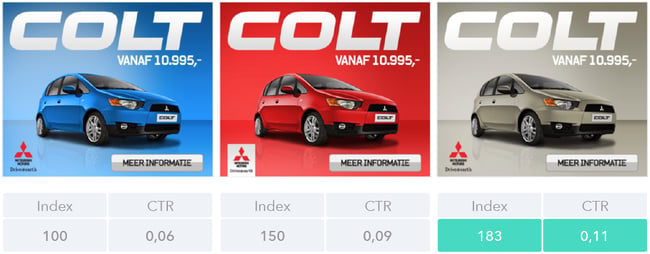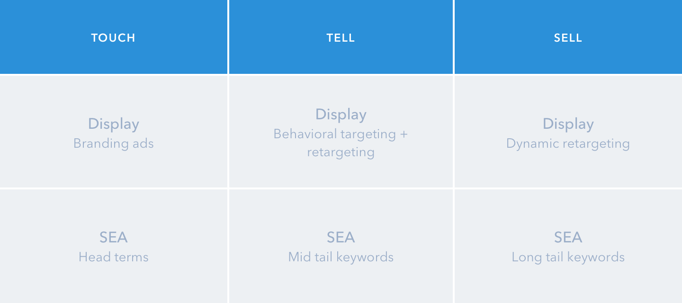Here’s a question: what insights do you have on how your ad campaigns are performing compared to your competitors? Using Google’s Display Benchmarks Tool and some Wordstream articles we have answered this question for you.
In 2018, the benchmark CTR for paid search ads was 3.17% and 0.46% for display ads. Interestingly, the tables turn when it comes to remarketing. Here, the CTR benchmark is 4.29% for search ads and 6.15% for display ads.
What’s your point, you may ask? Well, for those of you that are not hitting these numbers, there is a job to be done. For those of you who are, what’s to stop you from doing even better? Either way, we’d like to share some simple ideas about how you can improve your ad campaigns.
Don't make this huge mistake
Studies show that we get our first design right only 8% of the time. Differently put, there’s a 92% chance your banners aren’t performing as well as they could. Display ads simply aren’t tested as often as text ads. This isn’t that surprising. A while ago, A/B testing display ads was a costly and time-consuming endeavor. However, with some simple tooling, you can test your display ads just as quickly as you would test your search ads. A great place to start would be to test the basics of your banners such as the copy, your call to action, and the colors and images used in your ad. Testing these basics will help you clarify the assumptions you have about your target audience.
What to test for in Display campaigns
When creating a display campaign you will have some assumptions on what content or colors will work best for the target audience you are trying to address. In the example below the effect of color on CTR is tested (courtesy of defransekamer.com, check out more of their awesome work on their website):

The initial assumption was that red would be the most eye-catching color since it has the best contrast. As expected, red outperformed blue by 50%. Surprisingly, red didn't outperform grey. This simple test shows that the highest CTR is yielded by banners that display products that consumers actually see themselves buying. After all, how many red and blue cars do you see driving around as opposed to neutral colored cars?
Knowledge gained by continuously testing your assumptions will lead to a better understanding of what resonates with your target audience and ultimately helps you to continuously improve the performance of your future campaigns.
Display ads have dramatic effects on conversions when combined with search
Traditionally, display is seen as a brand recognition mechanism and paid search as a conversion mechanism by marketers. Now that programmatic is common practice, display and search should no longer be planned in isolation. Studies show that display advertising has dramatic effects on conversions when combined with search. Microsoft reports a steady increase in paid search impressions (54%), clicks (72%) and conversions (47%). Moreover, a 2014 Harvard study reports a return of €1.24 for display and €1.75 for search ads for every €1 invested in display and search.
.png?width=720&name=inline%20visual%201%20(1).png)
How you’re leaving money on the table
Not accounting for the synergy of search and display ads can lead to overspending on some actions and underspending on others, leaving money on the table. Going about harmonising both disciplines starts at the planning phase of your marketing campaign. Outline your overarching campaign goals and then aligning your search and display ads towards these goals. Here’s how you could cover your whole customer journey:

Make sure to align the theme of your search campaign with your display campaign, by using the same copy in both your search and display ads. This ensures consistency in your messaging which in turn promotes trust. Another quick win is to re-target on search words with matching display ads, allowing you to up-sell/cross-sell those who don’t convert. Finally, take into account all these efforts when analysing your results. Don’t analyse each campaign as stand-alone. A display ad may not produce clickthroughs, yet may still play a critical role in influencing a purchase.
Implement three improvements to improve your marketing campaigns
A considerate number of marketers seem to lack insights on the performance of their ad designs, and with that, in what resonates with their audience. But spending some time implementing simple improvements in three areas will have a very notable impact on your overall performance.
First, formulate some hypotheses to test your ads. If you could do with some inspiration, this whitepaper on creative optimization is for you. Don’t feel like reading anymore? We have a fun webinar too. Second, don’t isolate your display campaigns from your other online marketing efforts, your search campaigns specifically. Aligning them will reinforce both efforts.
Finally, keep your funnel in mind. Don’t just re-target the bottom of your funnel or focus only on filling the top. Make sure you have a creative for each stage.
There are solutions for the disproportionate amount of energy that some marketers believe is required for setting up enough creatives to put all this into practice. Yes, we are talking about ourselves here. Feel free to reach out to us if you could use a little help with setting up your display strategy.

.png?width=720&name=inline%20visual%201%20(1).png)


